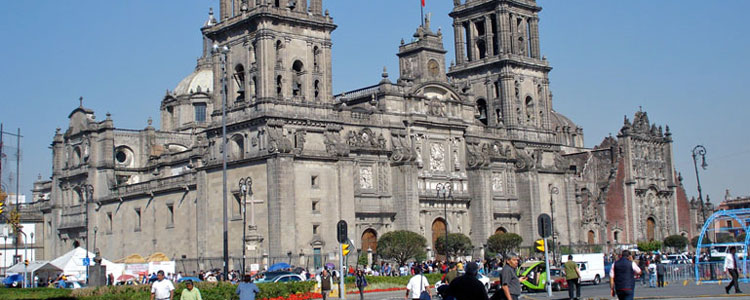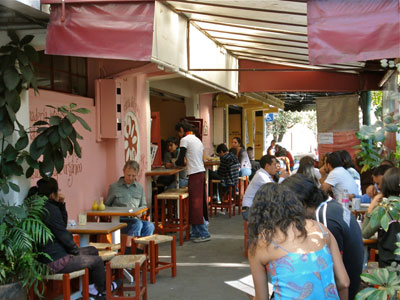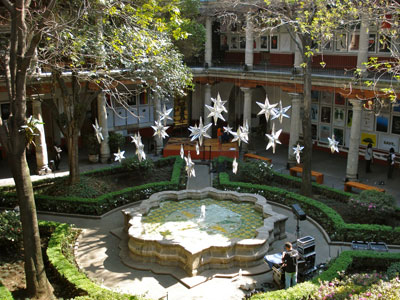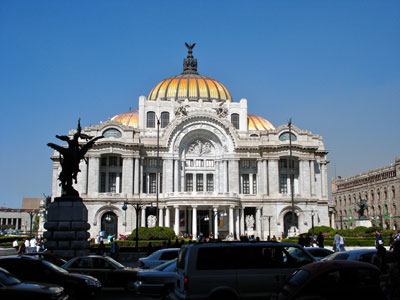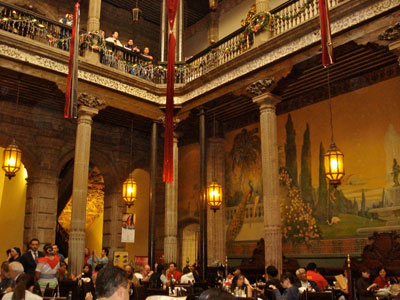A month in Mexico City
Text by Margo, Photos by Carole Shereda; Livingston, TX
My month-long stay in Mexico City with my friend Carole was an experiment. I had spent Christmas in Mexico City in the 1980s and it became one of my more memorable holiday experiences, so I wondered, ‘Could it be duplicated?’ However, we were up against another memory: a mugging on the Metro there in 1998. Could this December ’10 experience override our memories from that fateful day in ’98 while re-creating my memories of a magical Christmas?
Our accommodations
For our stay in the city, we rented a studio apartment for $650 for the month. The owners of Casa Tarami (phone, from the US or Canada, 619/400-3251), Katy (originally from Belgium) and her husband, Gabriel (a Mexican of Lebanese descent), were a delight. They are in their 70s and met in Chicago, of all places. They are wonderful storytellers and even had a little get-together with wine and hors d’oeuvres for several of their tenants to celebrate the Christmas holiday season.
Their apartments are located in Colonia Cuauhtémoc, an upper-middle-class neighborhood that is convenient to the Metro and very walkable.
We rented the couple’s only upper studio apartment, which was very cozy because the sun came in first thing in the morning. (Mexico City is typically chilly in the evenings.) All the other apartments (six in all, I think) were at street level and seemed dark and cold.
We did recommend this complex to a couple who stayed in an apartment facing the street and they felt it was okay, but Casa Tarami might not suit everyone.
Discovering the city
We discovered that Mexico City is a rather cosmopolitan city. Just two blocks from our apartment we enjoyed delicious vegetable tempura at Restaurante Daikoku (Rio Pánuco No. 170). We ate there two times and not only enjoyed the meal (150 pesos, or $11) but marveled at how crowded it was during each visit.
The newly opened Centro de Cultura de la India (Anatole France No. 319) in Colonia Polanco was quite a find also. We actually stumbled onto the Indian Cultural Center during our walk to find something else. The man we met at the door introduced himself to us as the new yoga teacher. He spent considerable time with us, including looking up recommended ashrams in southern India.
It was the Jerusalem de Mexico shop (Ejército Nacional No. 700), also in Colonia Polanco, that we had been trying to locate. We almost missed this store, which touted itself as having everything necessary to practice Judaism. At first we couldn’t find it, then, when we did, the door was locked. We were afraid the shop was closed, but we peeked through the window and saw someone inside, who then responded to our knocking.
Once through the door, we were rewarded with the most amazing array of religious articles on Judaism that we have ever seen all in one place.
We cannot forget to mention another find, Cinema Lumiere Reforma (Rio Guadalquivir No. 104). Located very close to our apartment in our very own Colonia Cuauhtémoc, the Lumiere Reforma is a foreign film theater. We went there only once but would have frequented it had the films playing at the time been of interest to us.
On our only visit, we attended a matinee at a bargain price of 26 pesos ($2) each and saw a relatively new film entitled “Red Social,” about the young man who invented Facebook (its name, as released in the US, is “The Social Network”).
Of course, the film had Spanish subtitles because it was among the foreign film offerings, which included films from Germany, Italy, the Middle East and elsewhere.
Museum visits
During our month-long stay, we made a few visits to museums. Our favorites were the Museo Franz Mayer (Hidalgo 45), which we had visited before, and the Museo Dolores Olmedo Patiño (Av. Mexico 5843), two kilometers west of central Xochimilco.
Admission to the Franz Mayer Museum is free to seniors, and entry to the Dolores Olmedo Museum is free on Tuesday, when we visited.
The Franz Mayer Museum was hosting an exhibition of Japanese graphics, which we enjoyed, but the real heart of this museum is its ambiance. It’s the kind of place one could return to time and again, if only to linger in the courtyard over coffee and dessert or a guidebook and a map.
The Dolores Olmedo Museum is a “must see,” and the getting there is almost as much of an adventure as a visit to the actual grounds of Olmeda’s 17th-century hacienda, filled with her huge collection of art and antiques. Outside the exhibit halls, we wandered the lovely grounds among peacocks and the pre-Hispanic hairless canines known as xoloitzcuintles.
Getting around
In exploring Mexico City, we walked and took the Metro, the Metrobús, the regular bus and a taxi (only twice). We were pleasantly surprised to discover that the city is one of the most accessible cities we have ever visited.
Taking the Metro was an amazing cultural experience in and of itself. For approximately 24¢, an individual can experience a slice of life underground.
There are underground shopping malls as well as medical and dental clinics. In one station, we saw an archaeological find uncovered during the Metro’s construction and, in another, a mural that was a work of art worthy of a museum wall.
Movers and shakers ate their lunches on the Metro, while others beat their drums or carried their luggage from one place to another. Vendors walked between trains selling piñatas, balloons, CDs, candy, gum and other items too numerous to mention.
During rush hour, women and their children were relegated to their own segregated cars to avoid the men who wouldn’t conform to the train rules: don’t touch, don’t push and don’t abuse.
The experience — jarring all five senses — was not a quiet one. Each vendor hawking his product tried to out-yell his competitor.
Having said all that, we found it to be the most efficient method for getting from point A to point B and beyond.
La Casa de los Azulejos (The House of Tiles) is a remarkable building, though it is currently occupied by Sanborns, a Mexican restaurant chain which might be compared to Denny’s in the US. The exterior of this fabulous 16th-century building is covered from top to bottom in decorative blue tiles. It is situated on the newly pedestrian-only Avenida Madero, in the city’s historic centro.
We ate our Christmas comida there only because we wanted to experience the lovely, traditional ambiance of the restaurant’s interior. We knew from prior experience that Sanborns’ food is mediocre and overpriced (we paid 183 pesos for our meal), so we were not disappointed. Go without expectations and settle for a snack of some sort and you will be impressed.
A bit of shopping
We came across a list of quirky attractions in our Lonely Planet “Mexico” book, and one, in particular, caught our attention. We probably wouldn’t have thought too much about it if we hadn’t met two sisters from Canada at one of the tourist information booths. They were our age and out for a little fun as well. Over coffee, we discovered our mutual likes and dislikes and discussed what attractions we might want to visit while in the city.
They had far less time in the city than we did, but we did join forces to try to find Mercado Sonora, which was described as an unusual market specializing in the occult and witchcraft. One does have to admire Mexico City for its diversity.
Another wonderful market, Mercado Sobre Ruedas, was described as especially clean and peaceful in one of our guidebooks. The very idea of a weekly street market being clean and peaceful intrigued us, so we walked over to Colonia Condesa to see for ourselves.
We spotted the pink awnings and table covers without difficulty. The block-long market was on Pachuca between Avenida Veracruz and Juan de la Barrera and apparently is held every Tuesday.
It was an outstanding market and was, indeed, one of the cleanest and most peaceful markets we have seen in all of Mexico. We only wish we had gone there with empty stomachs because all the food being sold looked very appealing.
Notable neighborhoods
We returned to Colonia Condesa a week or so later and went looking for Origenes Orgánicos (Plaza Popocatépetl 41A), a vegetarian restaurant. We had an awful time trying to find the street among all the other curvy and winding streets in the district, but the more difficult it became, the more determined we were! Finally we found the place just where our guidebook said it would be. Enjoy a vegetarian comida at this open-air restaurant and watch all the “beautiful people” go by. We paid 300 pesos for our meal.
Colonia Condesa is upscale and charming with all its park-like walkways in the middle of the boulevards. It should not be missed.
Another area worth visiting is Colonia Coyoacán, which was once a suburb of Mexico City until the two cities collided and almost became one. However, this colonia (neighborhood) has its own special charm.
We visited on a Sunday, which is their market day, and made a point of trying to find La Casa del Pan Papalotl (Av. Mexico No. 25), a vegetarian restaurant at the corner of Xicoténcatl.
We had originally discovered this small chain of restaurants in San Cristóbal de las Casas and even met Kippy, the owner, who is originally from California. She sat down with us then and explained how she came to open up this restaurant, wanting to offer a healthy alternative to the Mexican population. We certainly enjoyed the food (113 pesos, total).
We were also encouraged to try one of the many Café El Jarocho stand-up coffee-and-hot chocolate shops in and around the colonia. We had no trouble finding one, as they seemed to be everywhere.
The fact that they didn’t have any tables or chairs didn’t seem to deter a soul; people simply stood, kneeled or found a place to park themselves in order to enjoy the benefits of Café El Jarocho. Of course, when in Rome… so we each indulged in a cup of chocolate (27 pesos for two).
Lastly, we found endearing examples of Mexico City’s service-oriented policy during our stay. The ultimate in “service with a smile’ were the lap robes we saw placed on each chair at an outdoor café on one particularly chilly evening. When we walked by, there already were customers sitting outside with the blankets wrapped around themselves.
Carole and I began 2011 with a move to a new city. A taxi picked us up at 7 a.m. and whizzed us off to the TAPO bus station, where we purchased tickets to Oaxaca. We arrived at the bus station in record time; Mexico City was still sleeping on this New Year’s Day morning, and there were few pedestrians and even fewer vehicles on the road. The bus trip — 6½ hours long — allowed lots of time for reflection on our visit to Mexico City. We will be returning.

